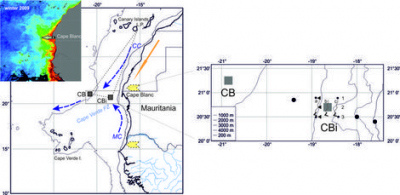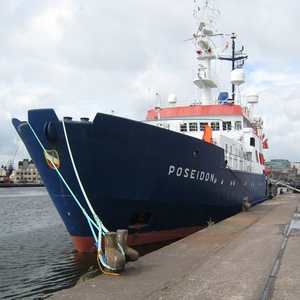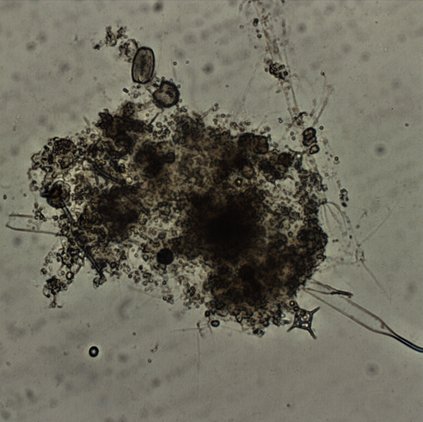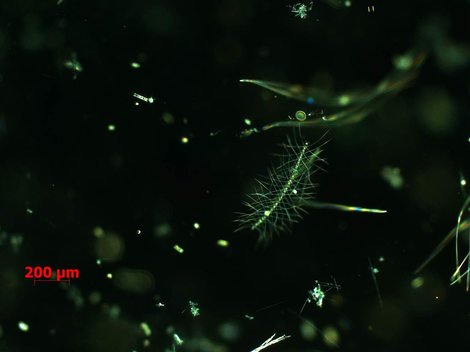Die Inhalte dieser Seite sind leider nicht auf Deutsch verfügbar.
Seitenpfad:
- SEAPUMP
- Ship cruises
- RV Poseidon POS508 - Jan/Feb 2017
RV Poseidon POS508 - Jan/Feb 2017
Poseidon POS508
Particle characteristics and transport of organic carbon off Cape Blanc
The Poseidon cruise POS508 is part of the long-term monitoring program by MARUM and University of Bremen off Cape Blanc. Export fluxes and particle dynamics have been studied in this region since 1988 (see Fischer et al. 2016).
During this cruise we study the formation and vertical transport of marine snow aggregates and fecal pellets. There aggregates are important processes for the ocean’s capability to sequester carbon. These larger settling particles are also vehicles for the transport of certain organic compounds and their associated paleo-proxies. These proxies are evaluated and calibrated by making use of our long-term particle flux records from the Mauritanian upwelling region. Our flux record of almost 25 years at the mesotrophic Cape Blanc sediment trap site also provides information on the decadal and intra-decadal variability and potential ecosystem changes in this important coastal upwelling area. Further, our process studies showed that sinking particles have undergone transformation and decay processes in the upper few hundred meters of the water column. These processes are mainly caused by microbial degradation and zooplankton ‘flux feeding’ on the sinking aggregates. However, we still know little about the influences from zooplankton grazing on the transformation and export of particulate organic particles and paleo-proxies. During the proposed cruise, we plan to exchange the two sediment trap moorings (CB and CBi) off Cape Blanc, as well as recover and re-deploy a new Bio-Optical Platform (BOP) developed between MARUM and AWI scientists. We will deploy free-drifting sediment trap arrays to study the short term variability of mass fluxes and the decay and transformation of large, organic-rich marine snow particles and fecal pellets in the epi- and mesopelagic. These process studies will be done in combination with different optical measurements of the vertical particle distributions and sizes through the water column. The water column will be sampled with water collectors, in situ-pumps, marine snow catcher, and vertical multi-net hauls. The major aim of the planned cruise will be to better quantify and understand the processes responsible for formation, transformation, and transport of organic particles and paleo-proxies through the water column off Cape Blanc, Mauritania.
The Poseidon cruise POS508 is part of the long-term monitoring program by MARUM and University of Bremen off Cape Blanc. Export fluxes and particle dynamics have been studied in this region since 1988 (see Fischer et al. 2016).
During this cruise we study the formation and vertical transport of marine snow aggregates and fecal pellets. There aggregates are important processes for the ocean’s capability to sequester carbon. These larger settling particles are also vehicles for the transport of certain organic compounds and their associated paleo-proxies. These proxies are evaluated and calibrated by making use of our long-term particle flux records from the Mauritanian upwelling region. Our flux record of almost 25 years at the mesotrophic Cape Blanc sediment trap site also provides information on the decadal and intra-decadal variability and potential ecosystem changes in this important coastal upwelling area. Further, our process studies showed that sinking particles have undergone transformation and decay processes in the upper few hundred meters of the water column. These processes are mainly caused by microbial degradation and zooplankton ‘flux feeding’ on the sinking aggregates. However, we still know little about the influences from zooplankton grazing on the transformation and export of particulate organic particles and paleo-proxies. During the proposed cruise, we plan to exchange the two sediment trap moorings (CB and CBi) off Cape Blanc, as well as recover and re-deploy a new Bio-Optical Platform (BOP) developed between MARUM and AWI scientists. We will deploy free-drifting sediment trap arrays to study the short term variability of mass fluxes and the decay and transformation of large, organic-rich marine snow particles and fecal pellets in the epi- and mesopelagic. These process studies will be done in combination with different optical measurements of the vertical particle distributions and sizes through the water column. The water column will be sampled with water collectors, in situ-pumps, marine snow catcher, and vertical multi-net hauls. The major aim of the planned cruise will be to better quantify and understand the processes responsible for formation, transformation, and transport of organic particles and paleo-proxies through the water column off Cape Blanc, Mauritania.

Map of the upwelling region off Cape Blanc.
References:
Fischer, G., Romero, O., Merkel, U., Donner, B., Iversen, M. H., Nowald, N., Ratmeyer, V., Ruhland, G., Klann, M., Wefer, G. (2016), Deep ocean mass fluxes in the coastal upwelling off Mauritania from 1988 to 2012: variability on seasonal to decadal timescales. Biogesciences 13, 3071-3090.
Fischer, G., Romero, O., Merkel, U., Donner, B., Iversen, M. H., Nowald, N., Ratmeyer, V., Ruhland, G., Klann, M., Wefer, G. (2016), Deep ocean mass fluxes in the coastal upwelling off Mauritania from 1988 to 2012: variability on seasonal to decadal timescales. Biogesciences 13, 3071-3090.

RV Poseidon.

Marine Snow aggregate collected off Cape Blanc. The aggregate is ~2 mm long.

Phytoplankton within a marine snow aggregate.


